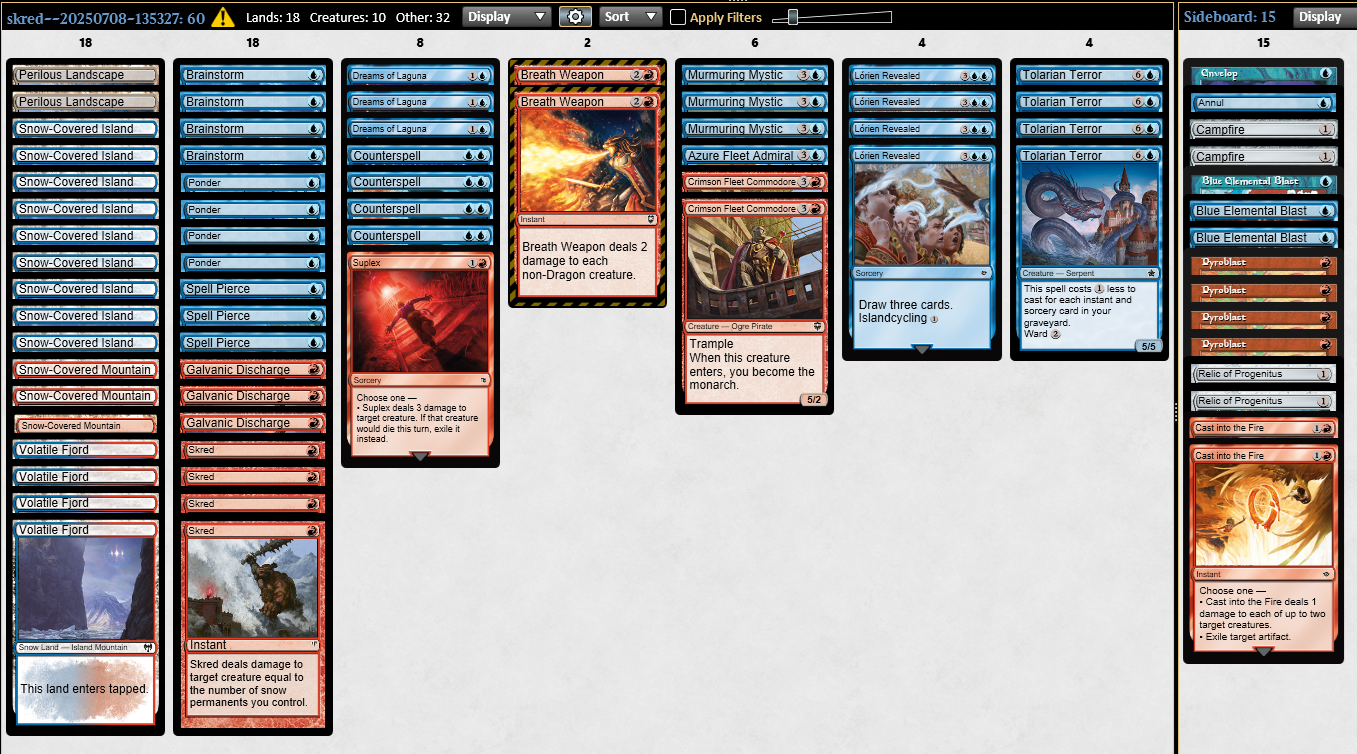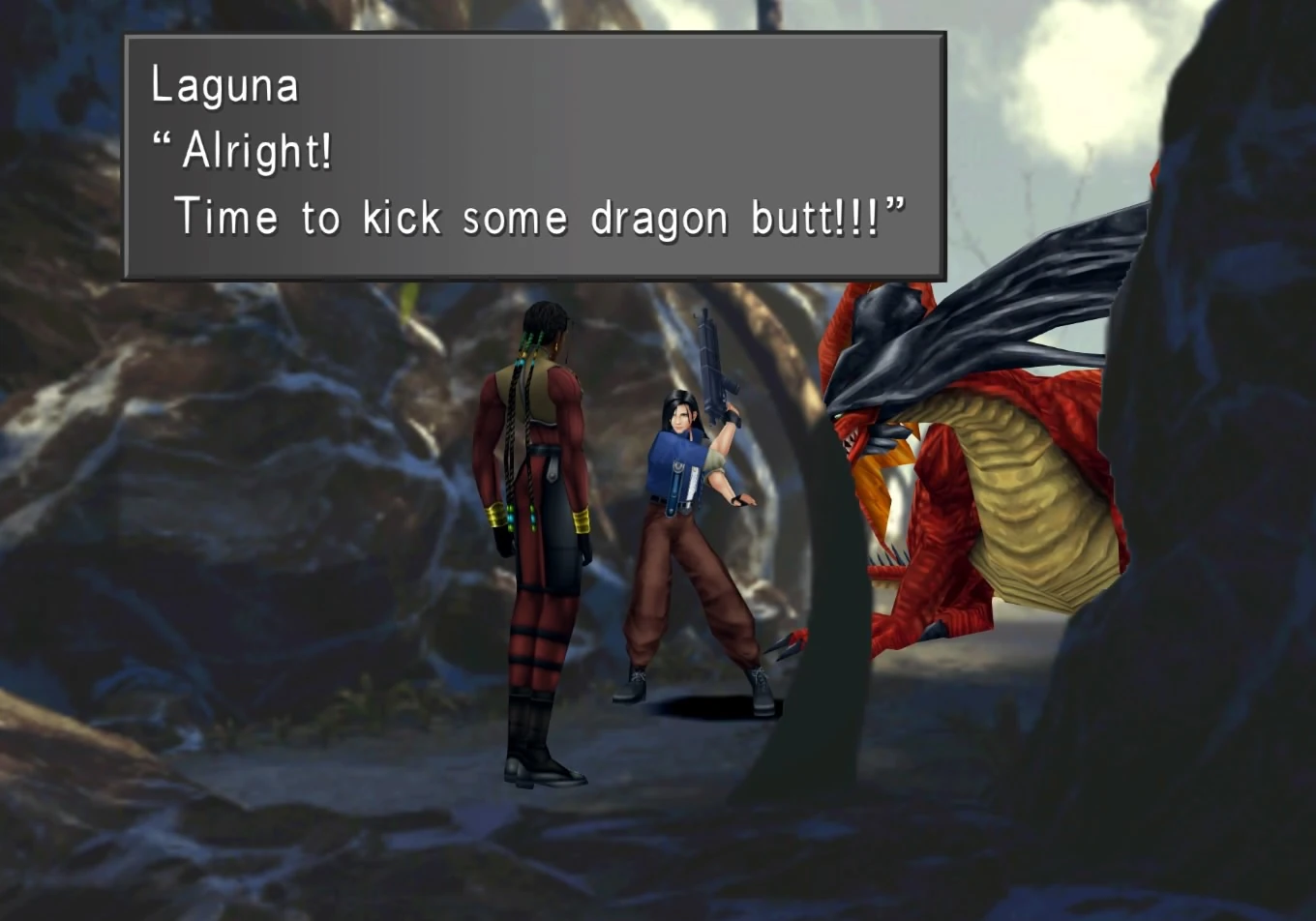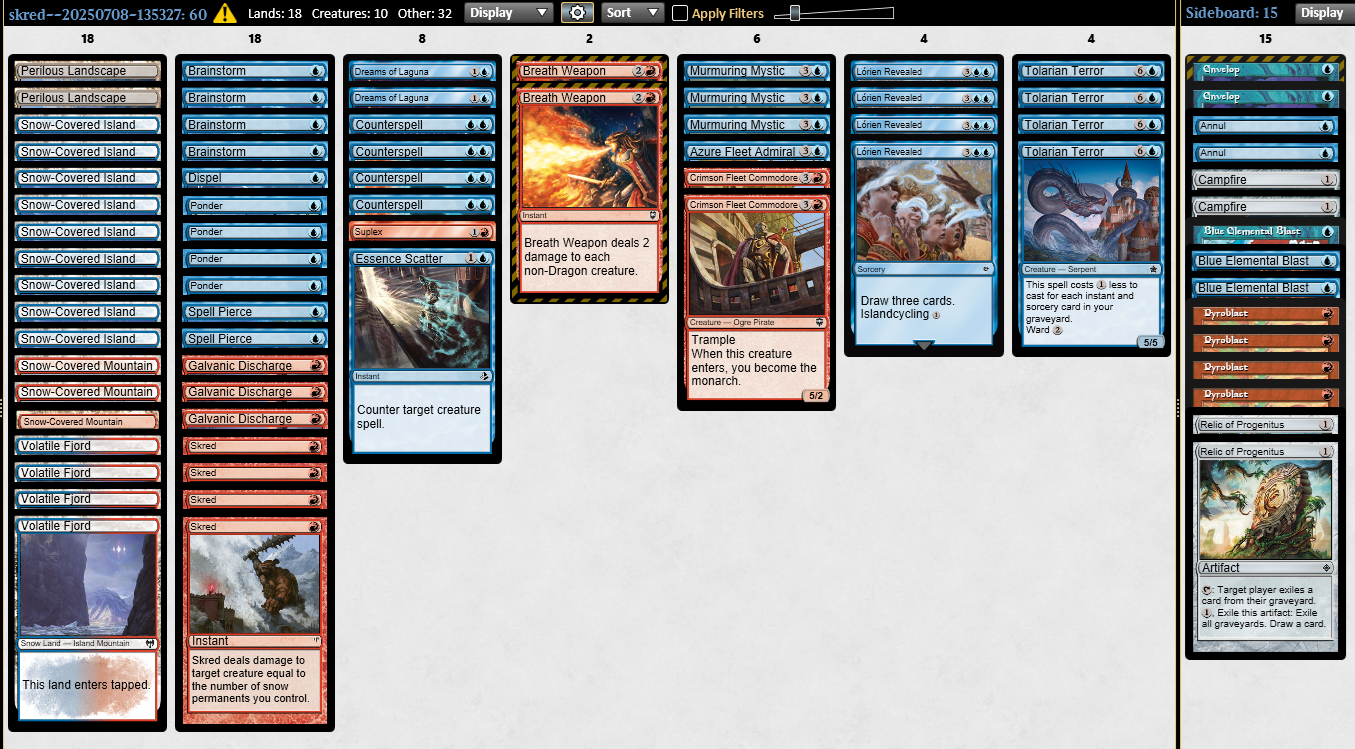Loading...
Products
Magic: The Gathering Line
When I first pitched this article to my editor, I planned to write a general tournament report and share my thoughts on the format. But after playing over the weekend, I changed my mind and decided to write a deck guide instead, for two main reasons:
In its most competitive form, Pauper felt like a two-deck format: monocolor aggro vs. Jund Midrange. The strongest monocolored aggro deck is Red Madness, an aggressive spellslinger build with plenty of ways to keep the burn flowing turn after turn. On the other side, Jund Midrange combines the format’s most powerful standalone cards, such as Familiar, Writhing Chrysalis, and Cleansing Wildfire, with the best card advantage engine (Deadly Dispute plus Ichor Wellspring), and a solid suite of removal spells.
Unfortunately, I didn’t enjoy playing either deck. When High Tide got unbanned, I gave that a serious shot, roughly 150 matches, before the meta caught up and players began dedicating 8 or more sideboard slots just to beat it. On top of that, the deck didn’t offer much in terms of agency outside the combo turn, and when I tried it on paper at my LGS, I realized I didn’t even enjoy how it played physically.
So I moved on from High Tide and picked up UW Familiars, a control/combo deck with strong matchups against both Jund and Burn, thanks to life gain and tons of card advantage. At first, I had an insane win rate across the field, but after a couple of weeks, I came to two conclusions:
On top of that, playing Familiars means you often get hit by hate aimed at High Tide. After losing a game where I discarded seven cards to Mind Extraction, I knew I had to drop the deck.
One week before the tournament. Panic mode.
The week before the tournament, I tried every deck, but none of them looked promising. I mostly tested blue control decks, because I feel I have an edge in long games, knowing I can play fast to deny draws, but also because I already play ten or more matches with blue decks every day, so I didn’t have to learn much. Still, every deck I tried felt awful for one reason or another, either you had no chance against aggro decks, or your late game was weaker than Jund’s.
Eventually, on the Wednesday before the event, my teammate Pietrvo Laudati came up with the Izzet Skred idea, telling me he was considering it. I copied his list, which was inspired by SpockVidaLoca from MTGO, and immediately felt that Skred was exactly what I wanted to play. I won most of my matches quite easily, going 4-1 in three leagues in a row, then I started to brew. Knowing I had to write this article, but also for science, I decided to try out a few new cards from Final Fantasy.
I already had Suplex in my Jeskai Ephemerate list, and the card felt like a literal suplex for the opponent every time I played it on a curve against Jund, so I decided to split the Bolts and add one copy. Then I saw a list by the phenomenal control player TSPJendrek that was running Dreams of Laguna, and I felt I had to play that too. No matter what, I knew I’d have a good story and a good time. Pauper events are always fun, and playing something I loved would help me enjoy the experience even more.
I tried three different lists in my three different events, and I still think I could submit a better deck. Here’s what I’d play in my next event:

The basic misconception about Skred is that it's a "control deck." That’s only partially true, because pure control doesn’t really exist in a format like Pauper, where there are no real wrath effects. On top of that, most decks in the format have inevitability, meaning that if you don’t turn the corner, they will eventually kill you. That was one of my main issues with Familiars, as I explained earlier.
Skred operates through three main game plans:
1) Resource Denial + Monarch
This is often the go-to plan against midrange decks. Spell Pierce on anything that impacts the board or ramps is a clean way to disrupt your opponent’s strategy, and an uncontested turn four Monarch is usually enough to take over the long game.
2) Tempo-Terror Plan
This involves developing your cantrips aggressively, digging for lands, cheap interaction, and Tolarian Terrors. Once your graveyard is stocked, you can resolve one or two Terrors while still holding up counterspells. This usually ends the game in two swings. It’s your best line against aggro decks with reach, basically any list running four Lightning Bolts. It works especially well against red decks, which are full of creatures that help fill your graveyard by dying to red removal. Outside of this plan, Tolarian Terror is often just a great blocker rather than a clock.
3) Mid and Late Game with Murmuring Mystic
Mystic is the closest thing Pauper has to a planeswalker. It stalls the board incredibly well and eventually wins the game, especially if you land a second copy. In grindy games, you can create enough Birds to go lethal once you’re close to decking. If you expect a lot of removal, Campfire can help by reshuffling your graveyard and extending your threat density.
These plans often overlap. For example, Mystic can help close games where Terror already gained traction, like against Mono-U Terror, and Monarch’s 5/2 body can swing a race when paired with a Terror. Post-board, you usually lean into one specific plan, cutting either Mystic, Monarch, or Terrors depending on the matchup.
I’m playing 4 Skred, 3 Galvanic Discharge, and 2 Suplex.
Galvanic Discharge is a better or worse Lightning Bolt, depending on the game. It has killed Writhing Chrysalis and Tolarian Terror, but it can’t go to the face when removal is dead, like against High Tide. Still, I believe it’s the best option, and I’ve had this discussion with several other UR players.
Suplex is a mediocre removal spell in many matchups, but it curves out decently considering the threats in the format. It also has the upside of exiling important cards like lands, Blood Fountain, and Sneaky Snacker. I’ve seen Marcio Carvalho’s list using Torch the Tower, and while it’s definitely a smart card, I still prefer Suplex. The reason is simple, if you don’t deal with something like Kessing Flamebreather immediately, and most of these cards have 3 toughness, you can easily lose in two turns. Playing a Shock effect doesn’t appeal to me in those scenarios.
I’m also playing two Breath Weapons in the main deck. Against aggro decks, you often side out the Monarch plan anyway, so having Weapon over Fiery Cannonade is always better to leave the board clear.
I’m on 3 Spell Pierce and 4 Counterspell.
Spell Pierce is amazing in the current meta, especially against red and Jund decks that like to curve out with noncreature spells on turn two. Surprisingly, it also stays relevant into the midgame, when sequences like Ichor Wellspring plus flashback Eviscerator's Insight can swing the game.
It also occasionally hits something unexpected, like a giant Nyxborn Hydra with bestow. I considered cutting one Pierce for a Dispel, and while I eventually chose not to, I still think there’s room for a Dispel in the list. It shines when you lean into the Mystic plan, letting you protect it from removal like Cast Down. I’m just unsure what to cut for it.
In the past, I played Essence Scatter over the third Dreams of the Laguna, but the card felt awkward. Most threats either trade poorly on mana with Scatter, or they generate value on the stack, like Chrysalis. That said, now that UW Caw-Gates won the event, I might consider running one Essence Scatter in the 75, since Skred has virtually no answer to Guardian of the Guildpact.

I’ve tried all the options for a card-advantage cantrip, from Behold the Multiverse to Deduce. Each one had its own problems, and while I don’t think Dreams of Laguna is perfect, I do believe it’s the best of the bunch.
First, Dreams' flashback ability provides extra value, allowing you to discard it to Refurbished Familiar and still get something later. Its cost of 1U is ideal, especially since it lets you use mana from Snow-Covered Mountain. Unlike Preordain, you can cast it at the end step while holding up a counterspell, and it’s another card you can cast from the graveyard when you have Mystic on board and are flooded with lands.
Hopefully, Pauper will eventually get something on the level of Expressive Iteration, but until then, Dreams is likely to stay in my main deck.
The sideboard continues to evolve, adapting to recent results and metagame shifts by swapping out cards that feel too narrow. Here’s the current configuration:
Cards I would like to play / try in the future:
These are my main ideas, and I’ll likely try them out in the near future. For the Magic Online meta, I usually run slightly different cards, so my submission there would look something like this:

Cast into the Fire tends to perform better in paper, where almost everyone is on Jund. Essence Scatter is a solid option against the current "hot deck" Spy Combo, but it’s also good against a wide range of other strategies.
On MTGO, running a third Campfire or a fourth Hydroblast always pays off, especially against grinders who triple-queue and consistently register Mono-Red in tournaments. If you’re looking for a slot, you can safely cut an Envelop.
Considering this article is made mostly for the MTGO community/events, I will use the above decklist as a model for my sideboard guide. If you want to play with older/different decklists you will still have some important info to better build your strategy.
This isn’t the easiest deck to navigate through, but we have multiple viable plans. Lately, I’ve been leaning toward a slower approach, cutting all four Tolarian Terrors and focusing on grinding down their resources. Cast into the Fire can act as a pseudo Sinkhole on turn one, and it remains valuable later in the game by exiling Refurbished Familiar or Blood Fountain. Annul helps cover your weak spots, especially against a huge Nyxborn Hydra.
An alternative strategy, which I used to prefer, involves running five to six “exile target artifact” effects in the 75, and aggressively Sinkholing the opponent while developing Monarch and Terror. This plan works particularly well if you’re playing Lightning Bolt, giving you some reach to close out the midgame.
While I currently favor the slower, grindy approach, both strategies are valid and have worked for me. No matter which route you take, always prioritize your Monarch cards, as they are your best tools in the matchup. If you expect a field full of Jund, adding a fourth Monarch effect to the 75 is a solid call.
+2 Relic of Progenitus
+3 Hydroblast
+2 Annul
-2 Breath Weapon
-1 Galvanic Discharge
-4 Tolarian Terror
You generally want to take the role of the control player in the first three to four turns, then transition into slamming a Tolarian Terror or establishing Monarch to start gaining card advantage or racing. The biggest threat to this plan is Sneaky Snacker, which can be quite annoying. I’ve considered bringing in Relic of Progenitus, but I’m still unsure. On the play, they might be fine but I’d rather keep in a Breath Weapon instead.
Overall, the matchup feels solid. We have nine one-mana hard counters, which gives us a strong edge in the early turns when they try to resolve key threats.
+2 Envelop
+3 Hydroblast
+2 Campfire
-3 Murmuring Mystic
-2 Dreams of Laguna
-1 Azure Fleet Admiral
-1 Breath Weapon
This matchup is similar to the Pingers one, but the suite of interaction is radically different. The main plan here is to control the board and always be prepared for a Goblin Bushwhacker blowout. Because of that, Monarch is quite bad in this matchup, it’s too slow and vulnerable, but Murmuring Mystic is absolutely incredible.
If they don’t have an immediate answer, just 2–3 Bird tokens can completely stabilize the board and shut down their pressure. Prioritize playing around burst damage and tempo swings, and you’ll usually come out ahead.
+2 Envelop
+3 Hydroblast
+2 Campfire
-3 Monarch
-2 Dreams of Laguna
-1 Dispel
-1 Suplex
This is a very favorable matchup, mostly because they play a higher-variance version of our deck, and crucially, without Pyroblast. Your primary game plan is to resolve a Murmuring Mystic when they’re not representing interaction. Don’t be afraid to take even 15 damage; untapping with Mystic usually means the game is yours.
Be mindful of Deem Inferior, but sometimes you just have to make them have it. Your Tolarian Terrors are generally used to trade, but they can pivot into a racing role, forcing your opponent into awkward blocks. Always prioritize Skred on their 6/5s; you might need to absorb some early damage from Delvers or Serpents, but preserving your long game is worth it.
A strong angle is to disrupt their mana base and deny development, especially when they’re relying on cantrips to find land drops or interaction.
Post-board, expect a lot of Hydroblasts. Always have a plan to protect your Pyroblast or Skred when trying to push through a lethal Terror if they have a single blue mana untapped.
-3 Galvanic Discharge
-2 Breath Weapon
-1 Suplex
+4 Pyro
+2 Relic
As long as you can land and protect Murmuring Mystic, this matchup is fairly easy. Your four Pyroblasts should help keep the board clear, and Breath Weapon acts as a solid reset, wiping out all of their creatures. They typically run a bunch of Hydroblasts and Dispels, so avoid risky lines that rely on red spells if you're behind on board.
+4 Pyro
+2 Campfire
-2 Spell Pierce
-3 Monarch
-1 Dreams of Laguna
This is a decent matchup, as long as you don’t leave yourself dead to a Gigadrowse. Make sure to counter at least one copy of it with Spell Pierce, keeping one Island untapped. Let High Tide resolve, since it boosts your Islands too, you’ll still be able to cast Counterspell afterward.
The easiest way to turn the corner is with Tolarian Terror, though Monarch also helps apply pressure. I usually let them attempt their first combo turn while I accumulate counterspells in the early game. If I manage to stop their first big attempt, I immediately shift gears, slam my threats, and aim to give them as little time as possible to recover.
Post-board, their plan remains the same, but we swap out bad removal spells for four Pyroblast. I also like the Campfire + Relic plan, since exiling Deep Analysis and then activating Campfire during your upkeep can reshuffle your deck and win the game on the spot.
I have 11 cards to side out and 10 to bring in. I usually leave in one Skred, just in case they board in Murmuring Mystic, though I’d rather not draw it. If you’re looking for a clean ins/outs swap, you could go -1 Hydroblast, +1 Dispel in the sideboard. That said, I wouldn’t recommend it, at least not for now.
+4 Pyroblast
+2 Envelop
+2 Campfire
+2 Relic
-3 Galvanic Discharge
-1 Suplex
-1 Essence Scatter
-2 Breath Weapon
-3 Skred
Cutting Cast into the Fire definitely makes the matchup harder, but it’s usually still pretty good. The must-answer threats are always the same: Priest of Titania and Timberwatch Elf, because they can either enable a massive Nyxborn Hydra, or just pump their creatures out of Bolt or Skred range. Murmuring Mystic is great at keeping up with their board, and Tolarian Terror is usually a solid way to pressure their life total or control the battlefield.
Postboard, I expect some blue spells, either Hydroblast or Spellstutter Sprite, but they’re easy to spot if your opponent starts acting suspiciously with Birchlore Rangers or Jaspera Sentinel. Cutting Monarchs for more interaction is the way to go. Also, remember that Spell Pierce can often counter a fully sized Hydra with Bestow.
+2 Envelop
+2 Campfire
-3 Monarch
-1 Spell Pierce
If you have cast, you can trim more on Pierces or Dreams, if you’re OTD.
This matchup used to be abysmal, but it's now more manageable considering the Paupergeddon winner’s list, which doesn’t run Guardian of the Guildpact. Our best shot is to get a 3-for-1 with Breath Weapon, or simply slam a Murmuring Mystic and protect it until we find a second one, building up board advantage in the meantime. Monarch is really helpful for maintaining card flow while we keep interacting with their threats.
Post-board, the gameplay remains mostly the same, just with more one-mana interaction coming from both sides.
+2 Relic of Progenitus
+4 Pyroblast
+2 Annul
-1 Suplex
-4 Tolarian Terror
-3 Galvanic Discharge
The general rule of thumb when sideboarding with this deck is to ask yourself: who is the beatdown? What are the key cards in my opponent’s deck? And what are mine?
If you’re the aggressor, you can often cut Murmuring Mystic. If you’re the control player, you can cut Tolarian Terrors. If you expect to fall behind on board, you can cut the Monarch package.
Dreams of the Laguna is a flex slot: strong against slower decks, but not great versus aggro. Other cards you can easily trim include Breath Weapon, Suplex, Essence Scatter, and Spell Pierce.
I feel this deck is a serious contender in this very open metagame. I hope this guide helped you understand the deck better, and encourages you to try the deck. My last tip is, if you want to switch cards, keep proportions. You can add more cantrips trimming some payoffs, but don’t trim payoffs to add removals, and so on. Mana curve and old concepts still have value, especially in pauper.
And for those who told me my deck was poor:
